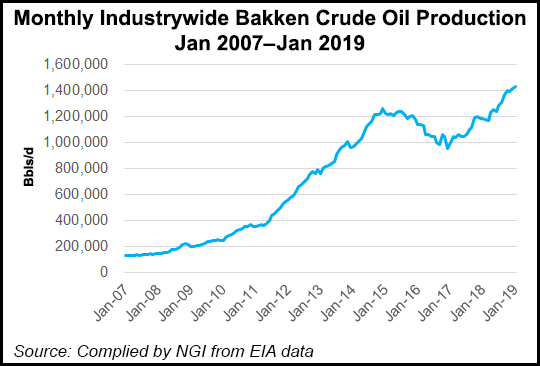Bakken Shale | E&P | NGI All News Access | NGI The Weekly Gas Market Report
Whiting Conjuring New Ways to Expand Bakken Output
Executives with Denver-based Whiting Petroleum Corp. are working on ways to apply the newest technology and operating tricks throughout the company’s core Bakken Shale assets to keep producing more oil and natural gas at better-than-break-even prices.

CEO Brad Holly said the company has advanced drilling and completion designs, dubbed 5.0, and it has redesignated Bakken acreage to Tier 1 quality from Tier 2.
Last year, Whiting was able to perform “some of the most innovative and effective completions in the Bakken,” he said. That revolutionized thinking “about what constitutes best practices” in the Williston Basin, including success in the Cassandra area.
Chief strategist Tim Sulser said value creation in the Bakken “continues to expand,” and Whiting is looking for ways to increase its footprint. Citing the application of advanced Generation 4 and 5 completions, the company has added or upgraded more than 450 locations.
“The right-sizing of completions will continue to make our highest quality acreage even better,” Sulser said.
In addition, COO Chip Rimer said Whiting has managed to stay in compliance with North Dakota wellsite gas capture goals to reduce flaring statewide. “We’ve been able to stay above the 88% capture rate with no problem.”
He attributed the compliance to the team’s ability “to take our plan and move it around, so we’re in places where we can move gas out of the systems.” A gas plant is to be installed before the end of March, and the producer can move portable gas plants where needed to aid in the capture efforts.
In the 4Q2018, production was 129,960 b/d, up 8% year/year. For 2018, production averaged 127,980 b/d, compared with 118,120 b/d in 2017.
A capital budget of $820 million at the midpoint of guidance is planned this year. Whiting expects to drill 132 wells, complete 154 and put 146 in production.
Net income was $204 million (5 cents/share) in 4Q2018, compared to a loss of $798.3 million (minus 17 cents) in 4Q2017. For 2018, net income was $342.5 million ($2.20/share) from a loss of $1.23 billion (minus ($1.31) in 2017.
© 2024 Natural Gas Intelligence. All rights reserved.
ISSN © 2577-9877 | ISSN © 1532-1266 | ISSN © 2158-8023 |
